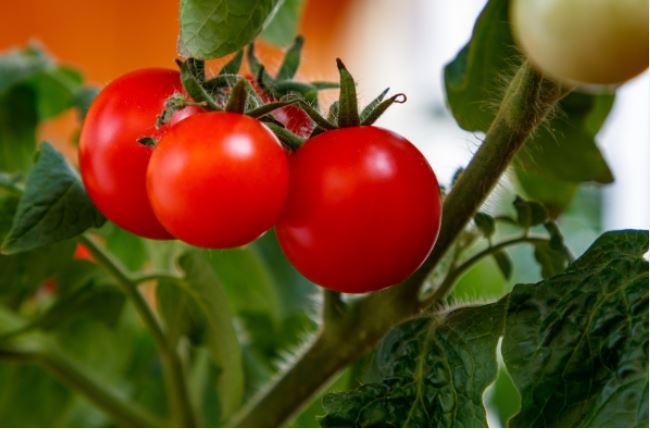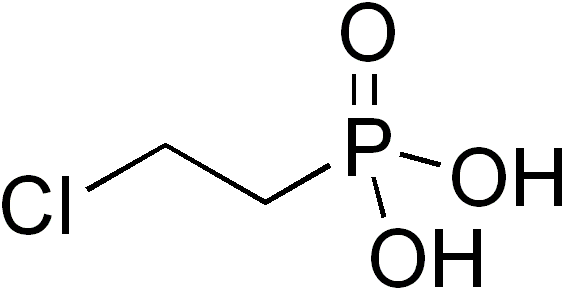The key difference between ethrel and ethephon is that ethrel is a versatile plant growth regulator that can improve coloration and accelerate the uniform ripening of fruits, whereas ethephon is the active ingredient in etherel.
A plant growth regulator is a chemical substance that profoundly influences the growth and differentiation of plant cells, tissues as well as, and organs. Etherel is a type of plant growth regulator that has ethephon as its major active ingredient.
CONTENTS
1. Overview and Key Difference
2. What is Ethrel
3. What is Ethephon
4. Ethrel vs Ethephon in Tabular Form
5. Summary
What is Ethrel?
Ethrel is a versatile plant growth regulator that can improve coloration and accelerate the uniform ripening of fruits. It is a plant growth regulator useful in accelerating tomato ripening, accelerating apple and blueberry coloring and maturity, loosening cherries, and reducing lodging in cereals. The active ingredient in this plant growth regulator is ethephon.

Figure 01: Ripening Tomatoes
Ethereal can be moderately toxic. It has the potential to cause severe skin and eye irritation, which falls under the toxicity category I. When using this substance for non-spur type trees, we can mix 4.25 liters of ethereal plant growth regulator in 1000 liters of water. We can apply it as a normal dilute spray until it runs off from the plant.
What is Ethephon?
Ethephon is a plant growth regulator. The chemical formula of this substance is C2H6ClO3P. Therefore, the molar mass of this compound is 144.49 g/mol. It has a higher density than the density of water (the density of ethephon is 1.4 g/cm3). It is poorly soluble in water, and its solubility depends on the temperature. The melting point of ethephon is 74 degrees Celsius. The other names that we can use to name ethephon include Bromeflor, Arvest, and Ethrel.
When concerning its mechanism of action, ethephon can convert into ethylene when it is undergoing metabolism by the plant. Ethylene is very important because it is a potent regulator for plant growth and the ripening of fruits. Moreover, ethephon is a butyrylcholinesterase inhibitor. The main hazard of ethephon is that it can be corrosive.

Figure 02: The Chemical Structure of Ethephon
Ethephon is used often for wheat, coffee, tobacco, cotton, and rice to accelerate plant growth and harvesting. Furthermore, cotton can be described as the most important single crop that uses ethephon. In this plant, it can initiate fruit creation over a period of several weeks. Also, it can promote early concentrated boll opening and the enhancement of defoliation, which can facilitate and improve the efficiency of scheduled harvesting.
In addition, ethephon can be useful in pineapples to initiate the reproductive development of the fruit. Moreover, we can spray this substance on mature green pineapple fruits to enhance the de-greening process, which is important in marketing requirements. Since ethephon sprayed on fruit can be quickly converted into ethylene, it is considered a low toxic substance.
What is the Difference Between Ethrel and Ethephon?
Plant growth regulators are very important. Ethereal is a type of plant growth regulator. The key difference between ethrel and ethephon is that ethrel is a versatile plant growth regulator that can improve coloration and accelerate the uniform ripening of fruits, whereas ethephon is the active ingredient in etherel.
Summary – Ethrel vs Ethephon
A plant growth regulator is a chemical substance that profoundly influences the growth and differentiation of plant cells, tissues as well as organs. Etherel is a type of plant growth regulator that has ethephon as its major active ingredient. The key difference between ethrel and ethephon is that ethrel is a versatile plant growth regulator that can improve coloration and accelerate the uniform ripening of fruits, whereas ethephon is the active ingredient in etherel.
Reference:
1. “Plant Growth Regulators.” Passel.
Image Courtesy:
1. “Tomatoes, vegetables, garden, leaves, food, healthy, fresh, tomato,…” (CC0) via Pxhere
2. “Ethephon” By Edgar181 – Own work (Public Domain) via Commons Wikimedia
ncG1vNJzZmivp6x7pbXFn5yrnZ6YsqOx07CcnqZemLyue9ahmK1lmah6tbTEZpuinpaav6a6wp5km52krLKmuoyeq6GqlaF6orrDZpytoJWltbC6jg%3D%3D